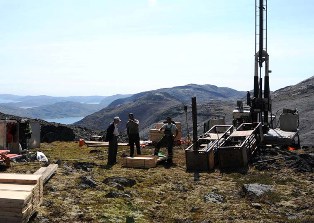Major Greenland uranium prospect
01 December 2008
A major rare earths orebody with uranium by-product has been confirmed in Greenland. Greenland Minerals & Energy (GME), an Australian-based company, has announced a major multi-element orebody with over 85,000 tonnes of uranium as a JORC-compliant resource. The Kvanefjeld deposit is eight kilometres inland from the coastal town of Narsaq, near the southern tip of the country. It has a deep water port.
 |
| Drilling at the Kvanefjeld deposit (Image: GME) |
The Danish Atomic Energy Agency proved up 43,000 tonnes of uranium in the early 1980s, but the deposit was not developed. In 2007, GME acquired it and undertook further drilling - nearly double that on which the earlier estimate was made. In May, it announced the new inferred resource figures of over 85,000 tonnes of uranium at 0.25% U, and cut-off of half that. The 2008 drilling programme is expected to move some inferred resources into the indicated category, and possibly increase the overall resource figure.
Since then, on 27 November, the country's 39,000 voters have voted in a referendum for self-rule, with 76% approving. In line with this, parliament has given strong support for uranium production as a by-product of rare earths, overturning a 20-year ban. Denmark, which colonised Greenland and almost 30 years ago granted home rule, is expected to maintain influence over foreign policy and defence, while allowing Greenland to take control of revenues from oil, gas and mineral resources.
Kim Kielsen, the raw materials minister, presented parliament with a report on the social and community aspects of uranium mining in Greenland and said that a public information campaign would address local concerns.
"South Greenland is one big uranium province and, regardless of where we dig, uranium ends up on our shovels," said Hans Kristian Schønwandt, GME's chairman.
The uranium comprises about 20% of the value of minerals able to be produced from Kvanefjeld.
The 2.6 million tonnes of rare earth oxides (REO) in the inferred resource comprise 75% of the value. They include neodymium (about 25% of REO value), lanthanum, cerium (nearly half the mass), praseodymium, terbium, dysprosium, yttrium and gadolinium. About 5% of the value of the deposit is sodium fluoride.
China produces some 90% of global REO output, but it already consumes most of this to supply its own industries which are dependent on elements such as neodymium and dysprosium for magnets, lanthanum and cerium for catalysts, and lanthanum, cerium, neodymium and praseodymium for nickel metal hydride batteries. Wolrd demand is increasing about 10% per year, but prices have been rising much faster.
Following the historic referendum and vote, GME requested a trading halt to 2 December and will make a formal release to the Australian Securities Exchange this week.
The company has a number of other exploration targets in the vicinity of Kvanefjeld.
In 2009, its activity will move to pre-feasibility study including reserve definition and process design, and environmental assessment.